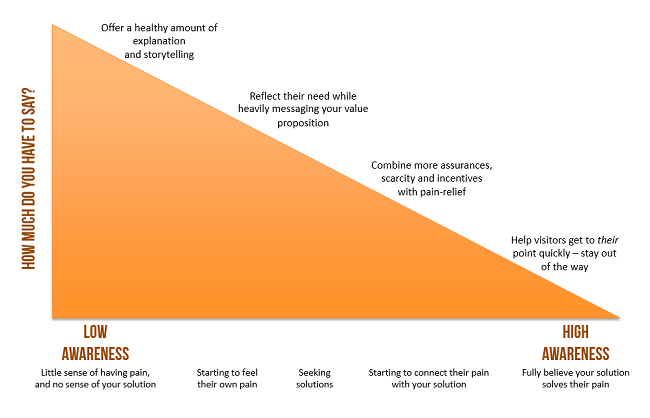There is a war raging in the world of eCommerce — and perhaps all of marketing. On one side, we find those who insist that short copy is best; on the other, passionate believers in the power of long-form copy.
This split in beliefs has created some conflicting advice for new store owners. You might be told that shorter is better, because customers have limited attention spans. But click through to the next article, and you’ll read that longer is better, that shoppers crave details, and short copy can’t possibly sell well.
And here’s where things get even more confusing: both sides are right.
There is no universal standard for the length of eCommerce product copywriting, and this is because every store has to find its own ideal length. For some stores and products, shorter may indeed be better. But for others, their shoppers really might crave those details that can only be found in longer copy blocks.
Let’s clear up any confusion, shall we? Today we’re going to help you find out what the best copy length for your store is. Keep reading to get started.
Why the length of your product copywriting matters (and when longer is truly better)
Let’s go all the way back to 1997, when the Nielsen Norman Group performed what was likely the very first study on how website visitors read. The summary of their findings was — a bit hilariously — “they don’t.”
The study found that 79% of subjects scanned or skimmed on-site text for important information, while 16% read word-for-word. Furthermore, promotional and data-littered blocks were noted as difficult to absorb, but when the copy was switched to bullet points, the same information was rated as 124% more usable.

When the test copy was updated, it was presented in a more convenient format, so that anyone scanning for important points could find them faster. It also cut out what the researchers felt was distracting (and potentially untrue):
Our conjecture […] is that promotional language imposes a cognitive burden on users who have to spend resources on filtering out the hyperbole to get at the facts. When people read a paragraph that starts “Nebraska is filled with internationally recognized attractions,” their first reaction is no, it’s not, and this thought slows them down and distracts them from using the site.
(Sorry, Nebraska.)
So what does all of this mean?
You probably already know that most of your visitors are going to skim for important information. But what they are skimming for varies drastically from store to store.
If you sell vacation packages, and your goal is to sell a Nebraska vacation to someone who already lives in the state, you’re not going to have to write very much. They already live there, they just might not know about some nice hotels or local destinations.
But if your goal is to sell a Nebraska vacation to someone who lives in Florida and has never been to Nebraska, you’ll have to write a lot more. Naturally, you’ll have to start by explaining why the state is worth the long trip, then talking about what there is to see and do, how much money a vacationer can save by not going to boring old California…

Get it? This second audience is going to want completely different information — and will need to read more to be convinced to take action — than the first one. Even if they skim, they’re still going to naturally require longer copy to decide to go on a Nebraskan vacation this summer.
It’s why you get brochures for vacation destinations, but postcards for takeout restaurants: it’s a lot harder to convince someone to go to Nebraska than it is to convince them to order a pizza.
By now we’ve hopefully made it perfectly clear that the length of your copy might vary based on its purpose and its audience. So let’s explore, step-by-step, how you can find those details and determine the right length.
The first thing to consider: the audience you’re trying to target
Knowing even a little bit about the shoppers who are coming to your store can help you determine exactly how much you need to write for them.
If your store’s been operating for a while, you can use data from Google Analytics to reveal important insights about your visitors. The Audience section of Google Analytics allows you to view visitor location, demographics, the devices they use to access your store, and much more.
How might this data impact the length of your copy? Think about factors like these:
- Preferred device — If the vast majority of your shoppers are browsing from a smartphone, product copy could take up too much room on their small screens, or simply be skipped.
- Location — Long, detailed blocks of information might be too difficult for those who don’t speak your native language to read. But if you only sell to one country, this won’t be an issue.
- Age — Younger shoppers might have less time to read and absorb information from copy than older ones.

If you’re writing product copy for a new store and can’t rely on any analytical data, try using other data sources to create personas that reflect who your ideal customers are. Here’s a fantastic piece from ConversionXL that explains why personas are so valuable, and which data sources you can use to make them.
Decide if your potential customers are already aware of a need for your products… or if you must convince them
As we already mentioned, it can take a significant amount of time to convince someone who lives in Florida that a vacation to Nebraska is worth taking. This is because someone living in Florida is probably unaware of any benefits of a Nebraskan vacation package.
If your potential customers are unaware of any need for your products, you’ll have to spend more time — and thus write more copy — to convince them to take action. But if they’re coming to your store already convinced that they need what you’re selling, you don’t have to do much selling at all.
This is a point discussed at length by Copy Hackers author (and WooCommerce user!) Joanna Wiebe in her post Should You Write Long Pages or Short Pages? She created this diagram to illustrate how a shopper’s awareness of your brand or products can impact just how much you need to say to them:

Joanna says:
Visitors on the Low Awareness end of the spectrum need to be brought up to High Awareness […] So if someone is Problem Aware, you need to reflect their pain early on the page. Then move them along to Solution Aware by telling them a solution exists. Then move them along to Product Aware by telling them your solution is the best for them. Then move them to Most Aware by giving them what they need to act now.
Though this advice was written primarily for landing pages, it absolutely applies to product copy, too.
So how can you know just how much selling you need to do with your copy? Some ideas:
- Think about how disruptive your products are. You don’t need a sales pitch to sell stick deodorant. But selling natural cream deodorant is going to require some convincing.
- Consider the format. It’s an easy decision to buy coffee, but a coffee subscription is a harder sell. Shoppers have immediate objections (“I don’t want to pay automatically”) and questions (“how often will I get my beans?”).
- Look at how familiar your shoppers become before buying. Google Analytics can show you the “touchpoints” most shoppers have with your brand and store before making a purchase. If they only generally view product pages, you’ll want to do most of your selling there. But if they’re learning about you elsewhere, that copy doesn’t need to sell quite as much.
Think about the amount of explaining your products require
Do you sell easy-to-wash T-shirts with funny sayings on them? Or do you sell handmade clothing with gorgeous details that can only bear the delicate cycle, and donate a portion of each purchase to a charity or nonprofit organization?
Shoppers don’t need you to explain a T-shirt to them, but they do need more details on products that require special care, come with their own documents, or impact more than a single customer. And those details can only come with… yep, you guessed it… longer copy.
Your product copy might need to be longer if your products:
- Require special care (such as storage, washing/drying, or handling)
- Include instructions or resources for assembly or usage
- Have an interesting backstory or unique details of some kind
- Benefit others
- Have purchasing requirements or limitations
If you want to get any of these details on the page but have already established that shorter is better for your customers, you can always opt for bullet points instead. You can try in-cart notices or on-page alerts, too.
Keeping keywords in mind? Watch that copy length
Product pages are one of the most common locations that keywords are added with search engine optimization (SEO) in mind. Although you’re likely to naturally use relevant words and phrases on your product pages, many store owners add additional relevant keywords to increase their chances of ranking well in search.
Though whether or not you create an SEO strategy for your product pages is entirely up to you, it’s worth keeping in mind that adding keywords to your copy will almost surely increase its length.
This can present a huge challenge to stores that want to keep their copy direct and straightforward, but still feel they need additional optimization to improve their rankings. And even for stores that do want longer copy, naturally adding keywords can be tricky.

Here’s something to think about: if your goal is to add keywords that are relevant to your store overall, you don’t have to put them on your product pages. Instead, you can add content to other locations, including:
- Your homepage
- Your “about us” or store biography page
- Category or landing pages
- Your content marketing (ex. your blog)
You’ll probably also find that you use keywords more naturally in these other locations.
If what you’re aiming to do is use product-specific keywords, but you’re certain that shorter copywriting is what your shoppers need, opt for different locations on the product page, like:
- Within your product specifications/bullet points
- In the product’s name
- In a secondary block of product copy elsewhere on the page — with WooCommerce, one way to do this might be to have a developer add your products’ “short description” to the top of your product pages, and the “long description” to the bottom
What’s important to keep in mind here, however, is that these additions should look natural. If they don’t, your potential customers might realize something is “off” and leave for another store.
If you can’t make adding keywords look natural, we say don’t do it — it’s not worth the risk of potentially losing a sale. (Or lots of sales.) The experience of your customers is always going to be worth more than ranking #1.
Finding the right copy length depends on your shoppers, your products, and your store’s needs
In the end, deciding how much copy to write for your products depends on what your potential customers need to take action. This might mean only a sentence or two, or it might mean a full page. You’ll only know what’s right if you evaluate their needs (and perhaps do a little testing to confirm).
For some more reading on how copy length and customer behavior are intertwined, we recommend this article on Crazy Egg’s blog The Daily Egg, which even includes screenshots of copy A/B tests from multiple well-known sites. As you’ll see, there’s no clear winner in the “war” between short and long copy… but there are ways to find out what’s best for you.
Have any questions or thoughts about this post? Or any suggestions of your own to add? We’re always eager to hear from you in the comments.